What we often refer to as the sorting algorithm is often referred to as an internal sorting algorithm, ie data records are sorted in memory.
Sorting algorithms can be roughly divided into two types:
One is the comparative sorting, the time complexity O(nlogn) ~ O(n^2), mainly include: bubble sort, select sort, insert sort, merge sort, heap sort, quick sort and so on.
The other is non-comparative sorting, and the time complexity can reach O(n), mainly including: count sort, base sort, bucket sort, and so on.
Here we discuss the commonly used comparison sorting algorithm, non-comparison sorting algorithm will be introduced in the next article. The following table shows the performance of common comparison sorting algorithms:
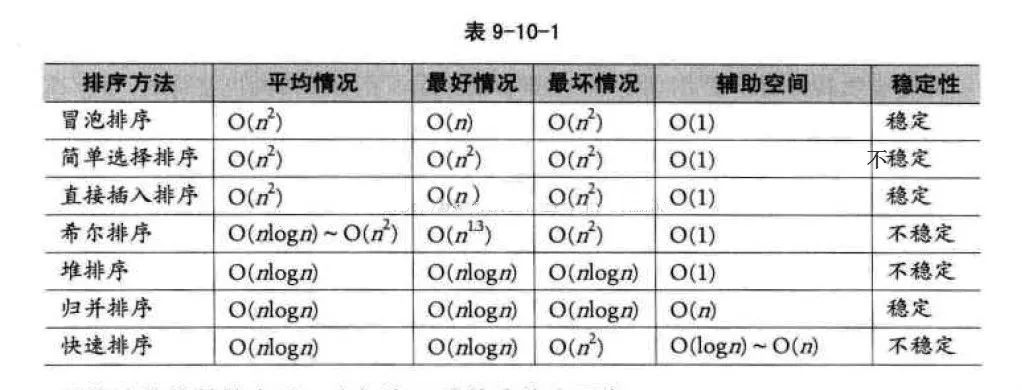
One thing we can easily overlook is the stability of the sorting algorithm.
The simple formalization of the sorting algorithm's stability is defined as: If Ai = Aj, Ai is prior to Aj before sorting, and Ai is still before Aj after sorting, the sorting algorithm is said to be stable.
In layman's terms, the relative order of two equal numbers before and after sorting is guaranteed.
For an unstable sorting algorithm, as long as an example is given, its instability can be illustrated; and for a stable sorting algorithm, an algorithm must be analyzed to obtain a stable characteristic.
It should be noted that whether or not the sorting algorithm is stable is determined by a specific algorithm. An unstable algorithm can become a stable algorithm under certain conditions, and a stable algorithm can also become unstable under certain conditions. algorithm.
For example, for bubbling ordering, which is originally a stable sorting algorithm, if the record exchange condition is changed to A[i] >= A[i + 1], two equal records will be swapped and become no Stable sorting algorithm.
Second, talk about the benefits of sorting algorithm stability. If the sorting algorithm is stable, then sorting from one key, and then sorting from another key, the result of the previous key sort can be used for the next key sort.
This is the case for cardinality sorting. First, sort by low order, and then sort by high order, and then the order of the elements after the low order is not changed when the high order is also the same.
Bubble Sort
Bubble sorting is an extremely simple sorting algorithm and the first sorting algorithm I learned.
It repeatedly visited the elements to be sorted, followed by comparing two adjacent elements, and if they were in the wrong order, they would be swapped in until they had no elements to exchange, and the sorting was completed.
The reason the name of this algorithm is derived is that the smaller (or larger) elements will slowly "float" to the top of the series via the exchange.
The bubble sort algorithm works as follows:
Compare adjacent elements. If the previous one is bigger than the latter one, swap the two of them.
Do the same for each pair of adjacent elements, starting with the first pair and ending with the last pair. After this step is done, the final element will be the largest number.
Repeat the above steps for all elements except the last one.
Repeat the above steps for fewer and fewer elements at a time until no pair of numbers need to be compared.
Due to its simplicity, Bubble Sort is often used to introduce the concept of algorithms to students of programming.
Bubble sorting code is as follows:
#include
// Classification -------------- Internal comparison
// data structure ---------- array
// Worst time complexity ---- O(n^2)
// Optimal time complexity ---- If you can use the internal flag for the first time when the internal loop is running, you can use a flag to indicate if there is a need for swapping. You can reduce the optimal time complexity to O(n).
// The average time complexity ---- O(n^2)
// Required auxiliary space ------ O(1)
// Stability ------------ Stable
Void Swap(int A[], int i, int j)
{
Int temp = A[i];
A[i] = A[j];
A[j] = temp;
}
Void BubbleSort(int A[], int n)
{
For (int j = 0; j < n - 1; j++) // Each time the largest element floats like an air bubble to the end of the array
{
For (int i = 0; i < n - 1 - j; i++) // Compare adjacent two elements in order to move the larger one backward
{
If (A[i] > A[i + 1]) // If the condition is changed to A[i] >= A[i + 1], it becomes an unstable sorting algorithm
{
Swap(A, i, i + 1);
}
}
}
}
Int main()
{
Int A[] = { 6, 5, 3, 1, 8, 7, 2, 4 }; // Bubble sorting from small to large
Int n = sizeof(A) / sizeof(int);
BubbleSort(A, n);
Printf("bubble sort result:");
For (int i = 0; i < n; i++)
{
Printf("%d ", A[i]);
}
Printf("");
Return 0;
}
The above code performs a bubble sort on the sequence { 6, 5, 3, 1, 8, 7, 2, 4} as follows:

The process of sorting a list of numbers using a bubble sort is shown in the right figure:
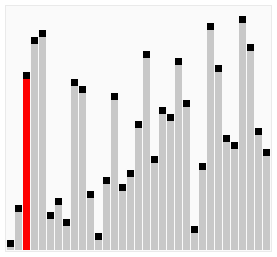
Although bubble ordering is one of the sorting algorithms that is the easiest to understand and implement, it is inefficient for sorting out a few elements.
Bubble Sorting Improvements: Cocktail Sorting
Cocktail sorting, also called directed bubble sorting, is an improvement over bubble sorting.
The difference between this algorithm and bubble sort is from low to high and then high to low, while bubble sort only compares each element in the sequence from low to high. He can get slightly better performance than bubble sort.
The code for cocktail sorting is as follows:
#include
// Classification -------------- Internal comparison
// data structure ---------- array
// Worst time complexity ---- O(n^2)
// Optimal time complexity ---- If the sequence has been mostly sorted at the beginning, it will be close to O(n)
// The average time complexity ---- O(n^2)
// Required auxiliary space ------ O(1)
// Stability ------------ Stable
Void Swap(int A[], int i, int j)
{
Int temp = A[i];
A[i] = A[j];
A[j] = temp;
}
Void CocktailSort(int A[], int n)
{
Int left = 0; // Initialize the boundary
Int right = n - 1;
While (left < right)
{
For (int i = left; i < right; i++) // In the first half, put the largest element behind
{
If (A[i] > A[i + 1])
{
Swap(A, i, i + 1);
}
}
Right--;
For (int i = right; i > left; i--) // In the second half, put the smallest element in front
{
If (A[i - 1] > A[i])
{
Swap(A, i - 1, i);
}
}
Left++;
}
}
Int main()
{
Int A[] = { 6, 5, 3, 1, 8, 7, 2, 4 }; // Small to large directional bubble sort
Int n = sizeof(A) / sizeof(int);
CocktailSort(A, n);
Printf("Cocktail sort result:");
For (int i = 0; i < n; i++)
{
Printf("%d ", A[i]);
}
Printf("");
Return 0;
}
The process of sorting a list of numbers using a cocktail order is shown in the right figure:
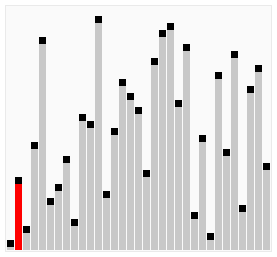
Taking the sequence (2,3,4,5,1) as an example, the sorting of the cocktails only needs to visit the first sequence to complete the sorting, but if using the bubble sort it takes four times.
However, in the random number sequence, the efficiency of cocktail sorting and bubble sorting is poor.
Selection Sort
Selecting sorting is also a simple and intuitive sorting algorithm.
Its working principle is easy to understand: Initially find the smallest (large) element in the sequence, place it at the beginning of the sequence as the sorted sequence; then, continue to search for the smallest (large) element from the remaining unsorted elements. To the end of the sorted sequence.
And so on, until all elements are sorted.
Pay attention to the difference between sorting and bubble sorting:
Bubble sorting places the current smallest (large) element in the proper position by sequentially swapping positions of two adjacent invalid elements.
Sorting each traversal once remembers the position of the current smallest (large) element, and finally only needs a swap operation to place it in the right place.
The sorting code is as follows:
#include
// Classification -------------- Internal comparison
// data structure ---------- array
// Worst time complexity ---- O(n^2)
// Optimal time complexity ---- O(n^2)
// The average time complexity ---- O(n^2)
// Required auxiliary space ------ O(1)
// Stability ------------ Instability
Void Swap(int A[], int i, int j)
{
Int temp = A[i];
A[i] = A[j];
A[j] = temp;
}
Void SelectionSort(int A[], int n)
{
For (int i = 0; i < n - 1; i++) // i is the end of the sorted sequence
{
Int min = i;
For (int j = i + 1; j < n; j++) // Unsorted sequence
{
If (A[j] < A[min]) // Find the minimum value in an unsorted sequence
{
Min = j;
}
}
If (min != i)
{
Swap(A, min, i); // put at the end of the sorted sequence, this operation is very likely to upset the stability, so the select sort is an unstable sort algorithm
}
}
}
Int main()
{
Int A[] = { 8, 5, 2, 6, 9, 3, 1, 4, 0, 7 }; // Sort from small to large
Int n = sizeof(A) / sizeof(int);
SelectionSort(A, n);
Printf("select sort result:");
For (int i = 0; i < n; i++)
{
Printf("%d ", A[i]);
}
Printf("");
Return 0;
}
The implementation of the above code selection sequence for the sequence {8, 5, 2, 6, 9, 3, 1, 4, 0, 7} is as shown in the right figure:

The macro process of using sorting to sort a list of numbers:

Selecting ordering is an unstable sorting algorithm. The instability occurs when the minimum element exchanges with A[i].
For example, the sequence: { 5, 8, 5, 2, 9 }, the smallest element chosen at a time is 2, and then swaps 2 with the first 5, thus changing the relative order of the two elements 5.
Insertion Sort
Insert sorting is a simple and intuitive sorting algorithm. It works very much like we grab poker

For unsorted data (cards caught in the right hand), scan backwards and forwards in the sorted sequence (left-handed ordered hands) to find the corresponding position and insert.
Insertion sorting is usually implemented in an in-place ordering (that is, only the extra space of O(1) is used for the sorting). Therefore, it is necessary to repeatedly shift the sorted elements backwards and forwards during scanning from back to front. , provides insertion space for the latest elements.
The specific algorithm is described as follows:
Beginning with the first element, this element can be considered sorted
Takes the next element and scans backwards from the back in the sequence of elements already sorted
If the element (sorted) is larger than the new element, move the element to the next position
Repeat step 3 until you find that the sorted element is less than or equal to the new element's position
Insert new element into this position
Repeat steps 2~5
Insert the sorted code as follows:
#include
// Classification ------------- Internal comparison
// data structure ---------- array
// Worst time complexity ---- worst case input sequence is descending, time complexity O(n^2)
// Optimal time complexity ---- The best case is that the input sequence is in ascending order, and the time complexity O(n)
// The average time complexity ---- O(n^2)
// Required auxiliary space ------ O(1)
// Stability ------------ Stable
Void InsertionSort(int A[], int n)
{
For (int i = 1; i < n; i++) // sorting like catching cards
{
Int get = A[i]; // The right hand catches a playing card
Int j = i - 1; // The cards in the left hand are always sorted well
While (j >= 0 && A[j] > get) // Compare the captured card with the hand from right to left
{
A[j + 1] = A[j]; // If the hand is bigger than the card it grabs, move it right
J--;
}
A[j + 1] = get; // Until the hand is smaller (or equal) than the card caught, insert the card that is caught to the right of the hand (the relative order of the equal elements is not changed, so insert Sorting is stable)
}
}
Int main()
{
Int A[] = { 6, 5, 3, 1, 8, 7, 2, 4 };// Insert from small to large
Int n = sizeof(A) / sizeof(int);
InsertionSort(A, n);
Printf("insert sort result:");
For (int i = 0; i < n; i++)
{
Printf("%d ", A[i]);
}
Printf("");
Return 0;
}
The above code implementation sequence for inserting the sequence { 6, 5, 3, 1, 8, 7, 2, 4 } is as follows:
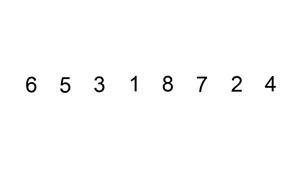
The macro process of sorting a list of numbers using insert sorting:
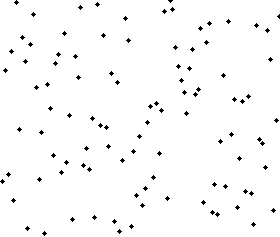
Insert sorting is not suitable for sorting applications with a large amount of data.
However, if the amount of data that needs to be sorted is small, for example, if the magnitude is less than a thousand, insert sorting is still a good choice.
Insertion sorting is also widely used in industrial-level libraries. In both the STL sort algorithm and the stdlib qsort algorithm, insert-ordering is used as a supplement to quick sorting, and is used to sort small numbers of elements (usually 8 or less).
Insert sorting improvements: two-point insertion sort
For insertion sorting, if the cost of the comparison operation is greater than the exchange operation, the binary search method can be used to reduce the number of comparison operations. We call it a two-division insertion order. The code is as follows:
#include
// Classification -------------- Internal comparison
// data structure ---------- array
// Worst time complexity ---- O(n^2)
// Optimal time complexity ---- O(nlogn)
// The average time complexity ---- O(n^2)
// Required auxiliary space ------ O(1)
// Stability ------------ Stable
Void InsertionSortDichotomy(int A[], int n)
{
For (int i = 1; i < n; i++)
{
Int get = A[i]; // The right hand catches a playing card
Int left = 0; // The cards on the left hand are always sorted so that you can use the dichotomy.
Int right = i - 1; // The left and right hand borders are initialized
While (left <= right) // Position the new card using the dichotomy
{
Int mid = (left + right) / 2;
If (A[mid] > get)
Right = mid - 1;
Else
Left = mid + 1;
}
For (int j = i - 1; j >= left; j--) // move the card to the right of the new card position by one unit to the right
{
A[j + 1] = A[j];
}
A[left] = get; // Insert the caught card into the hand
}
}
Int main()
{
Int A[] = { 5, 2, 9, 4, 7, 6, 1, 3, 8 };// Insert from 2nd to 2nd
Int n = sizeof(A) / sizeof(int);
InsertionSortDichotomy(A, n);
Printf ("two-insert insertion sort result:");
For (int i = 0; i < n; i++)
{
Printf("%d ", A[i]);
}
Printf("");
Return 0;
}
When n is large, the number of comparisons of binary insertion sorting is much better than the worst case of direct insertion sorting, but it is worse than the best case of direct insertion sorting. When the initial sequence of elements is close to ascending order, direct insertion sorting Less than two-insertion sort comparisons.
Binary insert sort elements move the same number of times as the direct insert sort, depending on the element's initial sequence.
More efficient insertion sorting improvements: Shell Sort
Hill sorting, also called decremental incremental sorting, is a more efficient and improved version of insert sorting. Hill sequencing is an unstable sorting algorithm.
Hill sorting is based on the following two properties of the insertion order and proposes an improved method:
Insertion sorting is efficient when operating on almost-ordered data, ie it can achieve linear sorting efficiency
But insert sorting is generally inefficient because insert sorting can only move data one bit at a time
Hill sequencing improves the performance of insertion sequencing by dividing all the elements of the comparison into several regions. This allows one element to move one step toward the final position in one go.
The algorithm then takes smaller and smaller steps to sort. The final step of the algorithm is the normal insertion ordering. However, at this step, the data to be sorted is almost always scheduled (in this case, the insert sorting is faster).
Suppose there is a small amount of data at the end of an array that has been sorted in ascending order. If the order is complexity O(n^2) (bubble ordering or inline sorting), n comparisons and exchanges may be performed to move the data to the correct position.
Hill sorting moves the data in larger steps, so small data can be moved to the right place with only a few comparisons and exchanges.
Hill sorts the code as follows:
#include
// Classification -------------- Internal comparison
// data structure ---------- array
// The worst time complexity---- varies according to the sequence of steps. The best known O(n(logn)^2)
// Optimal time complexity ---- O(n)
// The average time complexity---- varies according to the sequence of steps.
// Required auxiliary space ------ O(1)
// Stability ------------ Instability
Void ShellSort(int A[], int n)
{
Int h = 0;
While (h <= n) // Generate initial increments
{
h = 3 * h + 1;
}
While (h >= 1)
{
For (int i = h; i < n; i++)
{
Int j = i - h;
Int get = A[i];
While (j >= 0 && A[j] > get)
{
A[j + h] = A[j];
j = j - h;
}
A[j + h] = get;
}
h = (h - 1) / 3; // decrement incrementally
}
}
Int main()
{
Int A[] = { 5, 2, 9, 4, 7, 6, 1, 3, 8 };// Sorting from small to large
Int n = sizeof(A) / sizeof(int);
ShellSort(A, n);
Printf("Hill sort result:");
For (int i = 0; i < n; i++)
{
Printf("%d ", A[i]);
}
Printf("");
Return 0;
}
Sort the hills in steps of 23, 10, 4, 1:

Hill sorting is an unstable sorting algorithm. Although one insert sorting is stable and does not change the relative order of the same elements, in the different insert sorting processes, the same elements may move in their respective insert sorts, and finally they are stable. Sex will be disrupted
For example, the sequence is: {3, 5, 10, 8, 7, 2, 8, 1, 20, 6}. When h=2, it is divided into two subsequences {3, 10, 7, 8, 20} and { 5, 8, 2, 1, 6 }, 8 in front of the second subsequence before being sorted, now inserts the two subsequences into order, getting { 3, 7, 8, 10, 20 } and { 1, 2, 5, 6 8}, ie {3, 1, 7, 2, 8, 5, 10, 6, 20, 8}, the relative order of the two 8s has changed.
Merge Sort
Merging ordering is an effective sorting algorithm created on the merge operation with an efficiency of O(nlogn). It was first proposed by von Neumann in 1945.
The implementation of merge sort is divided into recursive implementation and non-recursive (iterative) implementation.
The recursive implementation merge sort is a typical application of the divide-and-conquer strategy in algorithm design. We divide a big problem into small problems and solve them separately. Then we use the answers of all small problems to solve the big problem.
The non-recursive (iterative) implementation of the merge sort is first performed in pairs, then merged in fours and fours, then merged in eights and eights, and continued until the entire array is merged.
Merge sorting algorithms mainly rely on Merge operations.
The merge operation refers to the operation of merging two already sorted sequences into one sequence.
The merge procedure is as follows:
Apply space to the size of the sum of the two sorted sequences used to store the merged sequence
Set two pointers, the initial position is the starting position of two already sorted sequences
Compare the elements pointed to by two pointers, select relatively small elements to put into the merge space, and move the pointer to the next position
Repeat step 3 until some pointer reaches the end of the sequence
Copy all the remaining elements of another sequence directly to the end of the merge sequence
The merged sort code is as follows:
#include
#include
// Classification -------------- Internal comparison
// data structure ---------- array
// Worst time complexity ---- O(nlogn)
// Optimal time complexity ---- O(nlogn)
// Average time complexity ---- O(nlogn)
// Required auxiliary space ------ O(n)
// Stability ------------ Stable
Void Merge(int A[], int left, int mid, int right) // Merge two sorted arrays A[left...mid] and A[mid+1...right]
{
Int len ​​= right - left + 1;
Int *temp = new int[len]; // auxiliary space O(n)
Int index = 0;
Int i = left; // the starting element of the previous array
Int j = mid + 1; // the starting element of the next array
While (i <= mid && j <= right)
{
Temp[index++] = A[i] <= A[j] ? A[i++] : A[j++]; // Guaranteed the stability of merging and sorting with equal signs
}
While (i <= mid)
{
Temp[index++] = A[i++];
}
While (j <= right)
{
Temp[index++] = A[j++];
}
For (int k = 0; k < len; k++)
{
A[left++] = temp[k];
}
}
Void MergeSortRecursion(int A[], int left, int right) // Merge sort recursively (top down)
{
If (left == right) // When the length of the sequence to be sorted is 1, the recursion starts backtracking and the merge operation is performed.
Return;
Int mid = (left + right) / 2;
MergeSortRecursion(A, left, mid);
MergeSortRecursion(A, mid + 1, right);
Merge(A, left, mid, right);
}
Void MergeSortIteration(int A[], int len) // Merge sort of non-recursive (iterative) implementation (bottom up)
{
Int left, mid, right;// sub-array index, the former is A[left...mid], the latter sub-array is A[mid+1...right]
For (int i = 1; i < len; i *= 2) // The size of the subarray i is initially 1, double each round
{
Left = 0;
While (left + i < len) // The next subarray exists (need to merge)
{
Mid = left + i - 1;
Right = mid + i <len ? mid + i : len - 1;// The size of the next subarray may not be enough
Merge(A, left, mid, right);
Left = right + 1; // Previous subarray index moves backward
}
}
}
Int main()
{
Int A1[] = { 6, 5, 3, 1, 8, 7, 2, 4 }; // Sorting from small to large
Int A2[] = { 6, 5, 3, 1, 8, 7, 2, 4 };
Int n1 = sizeof(A1) / sizeof(int);
Int n2 = sizeof(A2) / sizeof(int);
MergeSortRecursion(A1, 0, n1 - 1); // Recursive implementation
MergeSortIteration(A2, n2); // Non-recursive implementation
Printf("recursive implementation merge sort result:");
For (int i = 0; i < n1; i++)
{
Printf("%d ", A1[i]);
}
Printf("");
Printf ("non-recursive implementation of merged sort results:");
For (int i = 0; i < n2; i++)
{
Printf("%d ", A2[i]);
}
Printf("");
Return 0;
}
An example of merging the sequence { 6, 5, 3, 1, 8, 7, 2, 4 } by the above code is as follows
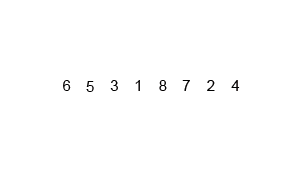
The macro process of sorting a list of numbers using merge sort:

In addition to sorting arrays, merge sorting can efficiently find array sums (ie monotonic sums) and reversed pairs in arrays. See this blog post for details.
Heap Sort
Heap sorting refers to a sorting algorithm designed using a heap data structure.
The heap is an almost complete binary tree structure (usually the heap is implemented by a one-dimensional array) and satisfies the nature: Take the largest heap (also called big root heap, big top heap) as an example, where the value of the parent node is always Greater than its child nodes.
We can easily define the heap sorting process:
Construct a maximum heap from the input unordered array as the initial unordered area
Interchange the top element (maximum) and tail element
Reduce the size of the heap (unordered area) by 1 and call heapify(A, 0) to start heap adjustment from the new heap top element
Repeat step 2 until the heap size is 1
The heap sorting code is as follows:
#include
// Classification -------------- Internal comparison
// data structure ---------- array
// Worst time complexity ---- O(nlogn)
// Optimal time complexity ---- O(nlogn)
// Average time complexity ---- O(nlogn)
// Required auxiliary space ------ O(1)
// Stability ------------ Instability
Void Swap(int A[], int i, int j)
{
Int temp = A[i];
A[i] = A[j];
A[j] = temp;
}
Void Heapify(int A[], int i, int size) // Heap adjustment from A[i] down
{
Int left_child = 2 * i + 1; // left child index
Int right_child = 2 * i + 2; // right child index
Int max = i; // Select the maximum of the current node and the child
If (left_child < size && A[left_child] > A[max])
Max = left_child;
If (right_child < size && A[right_child] > A[max])
Max = right_child;
If (max != i)
{
Swap(A, i, max); // Exchange the current node with its largest (direct) child node
Heapify(A, max, size); // Call recursively, continue down heap adjustment from current node
}
}
Demonstration of heap sort algorithm:
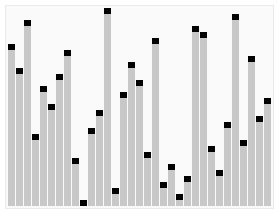
The animation simply shows the process of creating the heap and the logical structure of the heap before the sorting process.
Heap sorting is an unstable sorting algorithm. The instability occurs at the moment when the top element of the heap exchanges with A[i].
For example, the sequence: {9, 5, 7, 5}, the top element of the heap is 9, and the heap will be sorted next. 9 and the second 5 will be exchanged, and the sequence {5, 5, 7, 9} will be obtained, and then the stack will be adjusted. {7, 5, 5, 9}, repeat the previous operation to get {5, 5, 7, 9} thus changing the relative order of the two 5s.
Quick Sort
Quick sorting is a sorting algorithm developed by Tony Hall. In the average condition, sort n elements to O(nlogn) times.
In the worst case, O(n^2) comparisons are needed, but this situation is not common.
In fact, quick sorting is usually significantly faster than other O(nlogn) algorithms because its internal loop can be efficiently implemented on most architectures.
Quick sort uses Divide and Conquer to divide a sequence into two subsequences. The steps are:
Pick an element from the sequence as a "pivot".
All elements smaller than the reference value are placed in front of the reference, and all elements larger than the reference value are placed behind the reference (the same number can go to either side). This is called a partition operation.
Steps 1 to 2 are recursively performed for each partition. The recursive end condition is that the size of the sequence is 0 or 1, and the whole is already sorted.
The quick ordering code is as follows:
#include
// Classified ------------ Internal Compare Sort
// data structure --------- array
// Worst time complexity - Each time the selected reference is the largest (or smallest) element, resulting in only one partition at a time, n-1 partitions are needed to end the recursion. Time complexity O(n^2)
// Optimal time complexity ---- Each time you select the benchmark is a median, so that each time you divide the two partitions evenly, you only need logn times to end the recursion. The time complexity is O ( Nlogn)
// Average time complexity ---- O(nlogn)
// The required auxiliary space ------ is mainly due to the use of the stack space caused by recursion (used to save local variables such as left and right), depending on the depth of the recursive tree, generally O (logn), the worst O(n)
// stability ---------- unstable
Void Swap(int A[], int i, int j)
{
Int temp = A[i];
A[i] = A[j];
A[j] = temp;
}
Int Partition(int A[], int left, int right) // Dividing functions
{
Int pivot = A[right]; // This selects the last element as a reference
Int tail = left - 1; // tail is the index of the last element of the sub-array that is less than the reference
For (int i = left; i < right; i++) // Traversing elements other than the datum
{
If (A[i] <= pivot) // Put the elements less than or equal to the baseline at the end of the previous subarray
{
Swap(A, ++tail, i);
}
}
Swap(A, tail + 1, right); // Finally, the reference is placed after the previous subarray. The remaining subarrays are both subarrays larger than the reference.
// This operation is very likely to disturb the stability of the following elements, so quick sorting is an unstable sorting algorithm
Return tail + 1; // Returns the index of the baseline
}
Void QuickSort(int A[], int left, int right)
{
If (left >= right)
Return;
Int pivot_index = Partition(A, left, right); // index of the benchmark
QuickSort(A, left, pivot_index - 1);
QuickSort(A, pivot_index + 1, right);
}
Int main()
{
Int A[] = { 5, 2, 9, 4, 7, 6, 1, 3, 8 }; // Quick sort from small to big
Int n = sizeof(A) / sizeof(int);
QuickSort(A, 0, n - 1);
Printf("Quick sort result:");
For (int i = 0; i < n; i++)
{
Printf("%d ", A[i]);
}
Printf("");
Return 0;
}
The process of sorting a list of numbers using quick sorting:
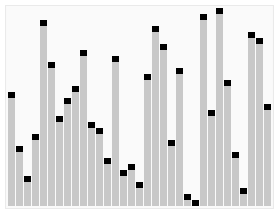
Quick sorting is an unstable sorting algorithm. The instability occurs when the reference element and A[tail+1] are exchanged.
For example, the sequence: { 1, 3, 4, 2, 8, 9, 8, 7, 5 }, the reference element is 5, and 5 is to be exchanged with the first 8 after a division operation, thus changing two elements 8 Relative order.
The Arrays.sort function provided by the Java system. For basic types, the bottom layer uses quick sorting. For non-basic types, the underlying uses merge sort. Why is this?
A: This is in consideration of the stability of the sorting algorithm.
For the base type, the same value is indifferent, and the relative position of the same value before and after sorting is not important, so a more efficient quick sort is chosen, although it is an unstable sorting algorithm;
For non-basic types, the relative positions of equal instances before and after sorting should not be changed, so choose a stable merge sort.
Lens Hood Silicone Rubber Plugs
Nantong Boxin Electronic Technology Co., Ltd. , https://www.ntbosen.com